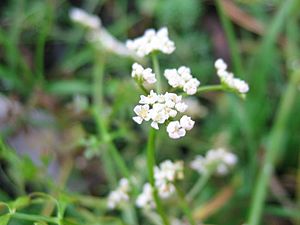Milk-parsley facts for kids
Peucedanum palustre (also known as milk-parsley) is a plant that grows for two years. It belongs to the Apiaceae family, which includes plants like carrots and parsley. It's called milk-parsley because its young parts have a thin, milky sap that doesn't smell very nice. This plant is found in most parts of Europe and extends east into Central Asia. Another common name for it is marsh hog's fennel.
Quick facts for kids Milk-parsley |
|
|---|---|
 |
|
| Scientific classification | |
| Genus: |
Peucedanum
|
| Species: |
palustre
|
| Synonyms | |
|
|
Where Milk-Parsley Grows
Milk-parsley, as its name palustre suggests, loves to grow in wetlands. You can find it in shallow water along the edges of rivers and estuaries. Sometimes, it also grows in ditches and other small watery places. This plant can handle some shade. It needs its growing spot to be covered by water sometimes during the year to help it compete with other plants.
This plant is very important to people who study butterflies, called lepidopterists. It is the main food plant for the caterpillars of the Old World swallowtail butterfly.
Looks Like Other Plants
There is another plant called Cambridge milk parsley, which is actually Selinum carvifolia. It's also an umbellifer (a plant with umbrella-shaped flower clusters), but it belongs to a different group of plants. These two plants look quite similar and grow in similar wet places.
However, you can tell them apart:
- P. palustre has stems that are hollow and often purplish. Its leaf parts are deeply divided. The small leaves under its flowers point downwards.
- S. carvifolia has solid, greenish stems. Its leaf parts are usually whole or only slightly lobed. The small leaves under its flowers point upwards.
When the plants have fruit, another difference appears. The fruit of S. carvifolia has three ridges that look like wings. The fruit of P. palustre does not have these winged ridges.
Historical Uses
The roots of Peucedanum palustre have been used in the past. In parts of Southeastern Europe and Russia, people used its roots as a substitute for ginger.
A British botanist named John Lindley also wrote about the root being used in the region of Courland in western Latvia. This area has many marshes and lakes, which is perfect for milk-parsley to grow. People there used the root to help with certain health conditions, like epilepsy.
See also
 In Spanish: Peucedanum palustre para niños
In Spanish: Peucedanum palustre para niños

